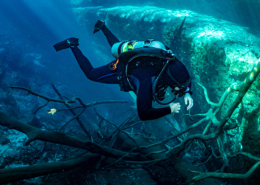How Long Should My No Fly Time Last After My Dive?
By: Jon Kieren
As divers, you have all seen the little airplane icon on your dive computer with a countdown timer next to it. Understanding where that number comes from and how to use it to plan your trips is important to avoid missing dives, or worse, having to miss your flight back home!
Why is there concern for flying after diving?
We are all aware of the reasons for staying within no decompression limits and performing safety stops, right? Well, think of your no-fly time as a “decompression stop” prior to flying. After a dive, we still have a significant amount of excess nitrogen dissolved in our tissues. If we ascend directly to altitude (generally above 6000ft), ambient pressure will decrease enough that we are at risk of having that nitrogen form bubbles just like if we overstay our no-decompression limits and make a direct ascent to the surface.
The cabin inside an airplane is pressurized, so why does it matter?
While the cabin is pressurized, it is typically pressurized to around 8000ft. This is above the typically accepted ceiling of 6000ft, so we need to wait long enough for our tissues to off-gas before hopping on our flight home.
How does the dive computer calculate our no-fly time?
Each computer manufacturer uses a slightly different method, however they will generally use their no-decompression algorithm just like they do on the dive. The no-fly icon essentially represents a mandatory decompression stop before our bodies have off-gassed enough for ambient pressure to be reduced to more than 6000ft of altitude. Because many manufacturers use different decompression algorithms and every dive profile is different, it is difficult to generalize across the board how long a diver will have to wait before their computer’s no-fly time clears after a dive trip.
How do we know when to schedule our flight home?
Luckily, Divers Alert Network (DAN) and the Undersea Hyperbaric Medical Society (UHMS) have done the work for us. They conducted a study on flying in commercially pressurized aircraft (Sheffield and Van 2004), and arrived at the following guidelines:
- A single dive within the no-decompression limits: 12 hours
- Repetitive dives of multiple days of diving: 18 hours
- Decompression dives (planned or unplanned): substantially greater than 18 hours
As a general guideline, DAN recommends allowing a minimum of 24 hours before flying to account for any variables (fatigue, dehydration, etc), as well as emergencies in flight such cabin depressurization.
So while your dive computer’s no-fly indicator is an additional tool to verify you are clear to fly, it is difficult to estimate what that no-fly time will be in order to plan a return flight home. When planning your diving vacation, it’s recommended that you allow at least 24 hours after your last dive before your scheduled flight. As a bonus, this ensures all of your gear will have plenty of time to dry out before you pack it away in your bags.










Leave a Reply
Want to join the discussion?Feel free to contribute!